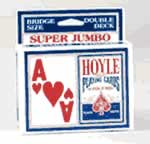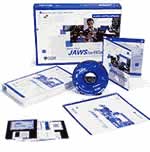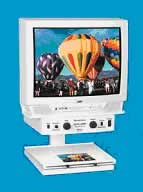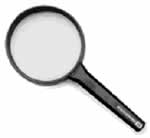DATI Assistive Technology Facts:
Aids for Low Vision
"If I have seen further than others, it is because I have stood on the shoulders of giants." - Sir Isaac Newton
What is assistive technology?
Assistive technology, or AT, is any tool that allows individuals with disabilities to use their own unique abilities to reach their goals. AT can range from low-cost tools such as a jar opener to more complex devices such as a power wheelchair or communication aid.
Infants, children, adults, and older persons with any type of disability can be aided by the use of AT.
What is an aid for low vision?
This AT category assists people with low vision or blindness by increasing contrast, enlarging images, or substituting tactile or auditory signals for visual ones.
What is the difference between legal blindness and low vision?
Under Social Security rules, an individual is legally blind if vision cannot be corrected to better than 20/200 in the better eye. People are also considered legally blind if their visual field is 20 degrees or less, even with corrective lenses.
Low vision, which includes legal blindness, is defined as a level of vision that is 20/70 or worse and cannot be fully corrected with glasses. A person with low vision has some useful sight.
In evaluating a person’s visual disability, it is important to assess how well a person uses the sight s/he has.
Who is affected by low vision and what causes it?
Vision impairment is not as common among young children as it is among older people. More than 80 percent of those with low vision are adults. The causes of low vision include disease, heredity, and injury. The most common age-related causes of low vision are cataracts, diabetes, glaucoma, and macular degeneration.
What types of devices are available for those with vision loss?
Products range from those that enhance visual information to make it more useful for those with some residual vision to those that convert visual information into auditory or tactile formats.
There are numerous products that improve access to visual information by enlarging it or enhancing its contrast against a background. Visual information on dials and control panels can be made accessible by adding raised marks, and products that normally produce visual signals (clocks, calculators) are available with enlarged numbers or auditory and/or tactile output. The font of printed materials can be enlarged via use of low-tech magnifiers or through use of closed-circuit television (CCTV) systems. Print materials can also be enhanced with the use of more legible fonts. Enhanced access to information on a computer display can be achieved using built-in software settings or screen magnification programs.
Alternate access to information on a computer monitor is possible via screenreading technology or devices that translate the information into Braille. Likewise, print materials can be scanned into the computer using optical character recognition (OCR) technology, and the digital files that result from this scanning process can be accessed using screenreaders or Braille output devices.
What are orientation and mobility AT devices?
Orientation and mobility products are included in the aids for low vision AT category. These devices help users move about and travel safely and independently. Items that assist people with orientation and mobility include white canes, guide dogs, and personal electronic mobility devices.
Where can I purchase aids for low vision?
A vast number of products exist. A low-vision specialist or AT specialist will be able to help you pinpoint your needs and find equipment responsive to them. Vendors or equipment demonstration-and-loan centers are good sources of equipment for trial periods prior to making final purchase decisions.
What are some things I should consider before making
a purchase?
- What is the extent of my vision loss?
- In what setting will I use this technology?
- What am I trying to accomplish?
- Will this product work for me?
- What funding sources are available for this purchase?
 |
Hoyle’s Jumbo Face Playing Cards have 1” enlarged numbers for easier visibility. |
 |
JAWS by Freedom Scientific is a screenreader that works with a PC to provide access to software applications and the Internet. |
 |
MagniSight Explorer Color CCTV has auto and manual focus capability. Place printed material under the camera and it is enlarged on the screen. |
 |
Optelec’s Basic Hand-Held Magnifier (2X) is a lightweight reading magnifier with a prescription-quality aspherical lense for distortion free viewing. |
| Learn More: AT Fact Sheets | ||||
Adapted Toys |
||||
Aids for Low Vision |
Viewing |
|||
Aids for Daily Living |
||||
Assistive listening devices |
||||
Augmentative and Alternative Communication (AAC) |
||||
Computer Access |
||||
Seating, Position and Mobility |
||||
Switches and Environmental Control Units |
||||
Delaware Assistive Technology Initiative
Center for Applied Science & Engineering
University of Delaware/Alfred I. duPont Hospital for Children
PO Box 269, 1600 Rockland Road
Wilmington, DE 19899-0269
1(800) 870-DATI or (302) 651-6790
TDD: (302) 651-6794
FAX: (302) 651-6793
dati-ud@udel.edu
www.dati.org
